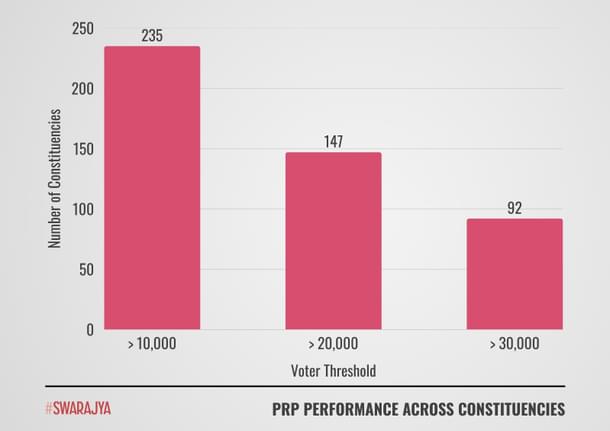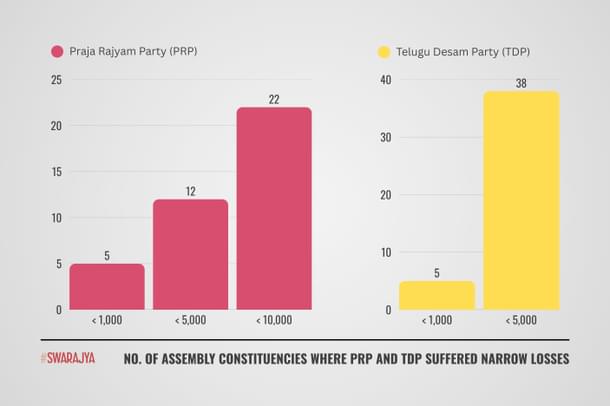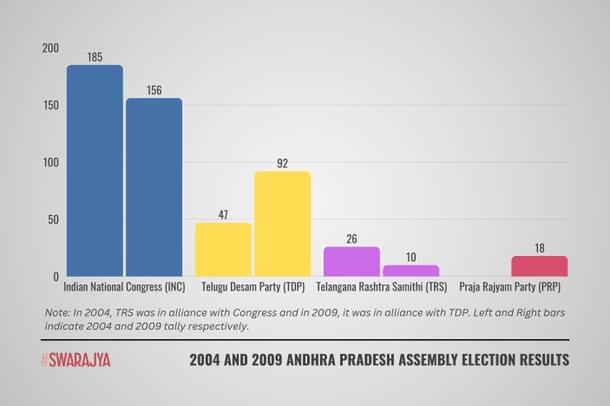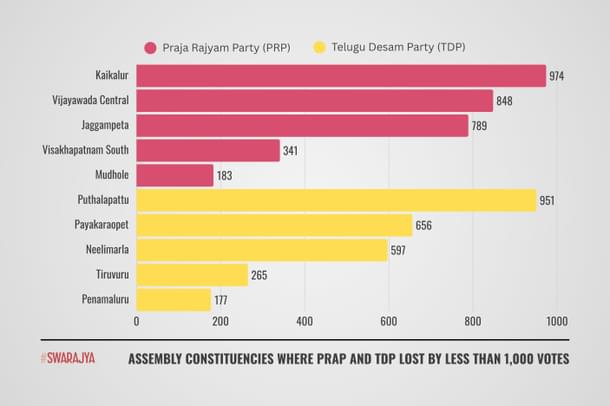Tamil Nadu
What Chiranjeevi's Andhra Experience Tells Us About Vijay's 'Vote Katua' Potential In Tamil Nadu
S Rajesh
Jul 10, 2025, 01:23 PM | Updated 03:33 PM IST
Save & read from anywhere!
Bookmark stories for easy access on any device or the Swarajya app.
No discussion about Tamil Nadu politics today starts without the speculations on how actor Vijay is going to perform in the 2026 elections.
The next speculation is often about which party his entry will harm more: the ruling Dravida Munnetra Kazhagam (DMK) or the opposition All India Anna Dravida Munnetra Kazhagam (AIADMK).
While that remains to be seen, and as this author argued in an earlier piece, he appears to be eroding more of the DMK’s base, it is always helpful to look for parallels to better understand the situation.
Tamil Nadu has seen many actors join politics, with the last big name being Kamal Haasan. Comparisons between the performance of his party, the Makkal Neethi Maiam (MNM), and Vijay’s Tamizhaga Vetri Kazhagam (TVK) keep happening.
But interestingly, there is also an example from neighbouring Andhra Pradesh, whose parallels are too similar to ignore.
‘Mega Star’ Was in the Same Boat as ‘Thalapathy’
The year was 2008. Actor Chiranjeevi, popularly known as ‘Mega Star’, had launched the Praja Rajyam Party (PRP) with the mission to give Andhra a new form of politics.
The state was then ruled by the Congress, which had a majority of its own. Y S Rajasekhar Reddy (YSR), who died in a helicopter crash the next year, was the chief minister. The opposition was led by the Telugu Desam Party (TDP) of Chandrababu Naidu.
The situation was thus similar to what it is like in Tamil Nadu today. The DMK is seeking re-election after one term, and there is a large party in the form of the AIADMK in the opposition. Vijay, like Chiranjeevi, is a very popular actor, who is promising change.
PRP’s Performance
The PRP did quite well in the elections held in 2009. It secured a vote share of 16.32 per cent and won 18 seats in the Assembly. In the Lok Sabha elections held simultaneously, it finished second in three constituencies.
Pollsters, who earlier said that Vijay could secure 5–8 per cent, are now confident that he is riding strong momentum and can surely secure a double-digit vote share, like the PRP.
While they still doubt whether that could translate into a significant number of seats, what they agree upon is that TVK will definitely influence the results, essentially acting as a 'vote katua' (vote-cutter).
Vote Katua, Yes, But How Big?
Next comes the question: how big a vote cutter can Vijay be? The last one from a cinema background that the state saw was Haasan. But his influence was limited to some seats. The Naam Tamilar Katchi too has not been able to do much except maintain a steady presence and mark its portion of the pie.
So they cannot tell us how exactly the situation could turn out to be. That is what brings us to the minutiae of the figures achieved by the PRP, which had a double-digit vote share, like what is being projected for Vijay.
Here are some important statistics that show how potent a new party led by an immensely popular celebrity could turn out to be.
In 235 out of 294 constituencies, the PRP secured more than 10,000 votes. The number is 147 if we consider places where they secured more than 20,000 votes, and 92 if the number considered is 30,000.

These numbers are significant because they are in a state that has a bipolar nature of politics, i.e. elections are closely contested, and a few thousand votes here or there can make or break the fortunes of either party.
Out of the 34 constituencies where it finished second, there were five seats where it lost by less than 1000 votes. In 12 seats, the margin was less than 5000, and in 22 seats, the difference was less than 10,000.

It had a good statewide performance, not just in coastal Andhra, where the population of Kapus (the caste to which Chiranjeevi belongs) is high. Even in the Telangana region, where sentiment for a separate state was quite strong by that time, it won two MLA seats, one in Adilabad district and the other in Nizamabad.
As a result of the PRP's entry, the Congress came back to power but with a reduced majority. It secured just eight seats more than the majority mark of 148 in the 294-member Assembly.
The TDP remained in the opposition.

Analysts hold that it was the TDP that was affected more by the PRP.
Both parties were vying for a similar demographic, i.e. the OBC and middle-class voters. In a state whose politics has been dominated by the Reddy and Kamma communities, the PRP gave a very large number of seats (104) to OBCs.
That is borne out by data.
While the TDP lost just five seats with a margin of less than 1000, a small increase in the margin to 5000 shows the extent of damage caused by the PRP. The number of such seats is a whopping 38.

Those 18 seats later proved crucial. Even before Chiranjeevi took the decision to merge his party with the Congress, it was the PRP's support that saved the government during a tumultuous time.
YSR's son Jagan Mohan Reddy had broken away from the party, taking along with him a number of MLAs. His newly formed outfit, the YSRCP, performed well in the bypolls held subsequently. Of the 18 seats that saw elections again, Jagan's candidates won 15. The ruling Congress could win only two.
While it may be difficult to conclude with certainty whose kitty the TVK will take more votes away from, and whether Vijay would later align with either of the Dravidian majors post-elections like Haasan or Chiranjeevi did, the PRP’s performance nevertheless has important lessons for what could happen in the 2026 elections.
Vijay could well be the 'difference' who determines which party will come to power in the state next year.
S Rajesh is Staff Writer at Swarajya. He tweets @rajesh_srn.





